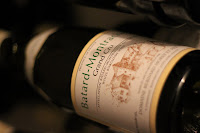The $200+ question

To spend or not to spend? That is the question! Last week I drank Grand Cru white Burgundy - Corton Charlemagne, Bienvenues-Bâtard-Montrachet, Bâtard-Montrachet, and Chevalier-Montrachet. A couple of great vineyards were missing from this exalted line-up, but believe me - it was exalted alright! We (as in "wino crowd") all know that 3 things matter - vineyard, vintage, producer. You leave out one of them, and you are as good as a sitting duck. 2006 - a vintage for white Burgundy that had received mixed comments from the aristocrati, though personally I found many brilliant wines. For the tasting lineup organized by a local wine shop, they picked the absolute top examples from the extensive portfolios by Girardin, Pernot, B. Morey, Boillot and Bouchard, ranging from $78/bottle to $235/bottle (and those were bargains at a 40% discount!) For reference, here are the wines I enjoyed: 1. 2006 Corton-Charlemagne (Vincent Girardin) $78 2. 2006 Bienvenue-Bâtard-Montrachet (Paul Perno
